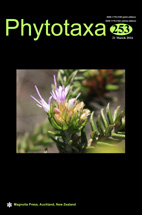Abstract
New Caledonia is one of the biodiversity hotspots with bryophyte endemism estimated to be up to 39% (Thouvenot & Bardat 2010; Thouvenot et al. 2011). A total of 151 species in 28 genera of Lejeuneaceae have been recorded in this country (Thouvenot 2015; Thouvenot et al. 2015; Müller et al. 2016). Lepidolejeunea bidentula (Jack & Stephani 1894: 107) Schuster (1980: 425) is a widespread species in E Africa, Oceania, and SE Asia. Piippo (1986) described a new variety known only from New Caledonia, L. bidentula var. novae-caledoniae Piippo (1986: 26), based on MacKee’s collections from New Caledonia. Although this variety is easily separated from L. bidentula var. bidentula by the long falcate apical tooth, Piippo (1986) considered that this taxon deserved varietal rank owing to the lack of sufficient understanding of the androecia at that time. In the course of our studies on the taxonomy and phylogeny of Lejeuneaceae, we encountered a male plant of this taxon with rich androecia in F. Müller’s collections from New Caledonia. The male plant clearly showed that the androecia are usually intercalary on short or long branches, and that male bracteoles (3−4) are present throughout the androecium (Fig. 1). In Lepidolejeunea bidentula var. bidentula, on the other hand, male bracteoles are always restricted to the base of the androecia. Whether the male bracteoles are born throughout the androecium or restricted to the base is one of the most reliable characters in Lejeuneaceae (Mizutani 1961; Grolle & Zhu 2000; Zhu & So 2001). Comparison of samples of the two varieties revealed further morphological differences such as the relative size of the ocelli, a character already observed by Piippo (1986). Therefore, it is appropriate to raise the variety novae-caledoniae to specific rank.

